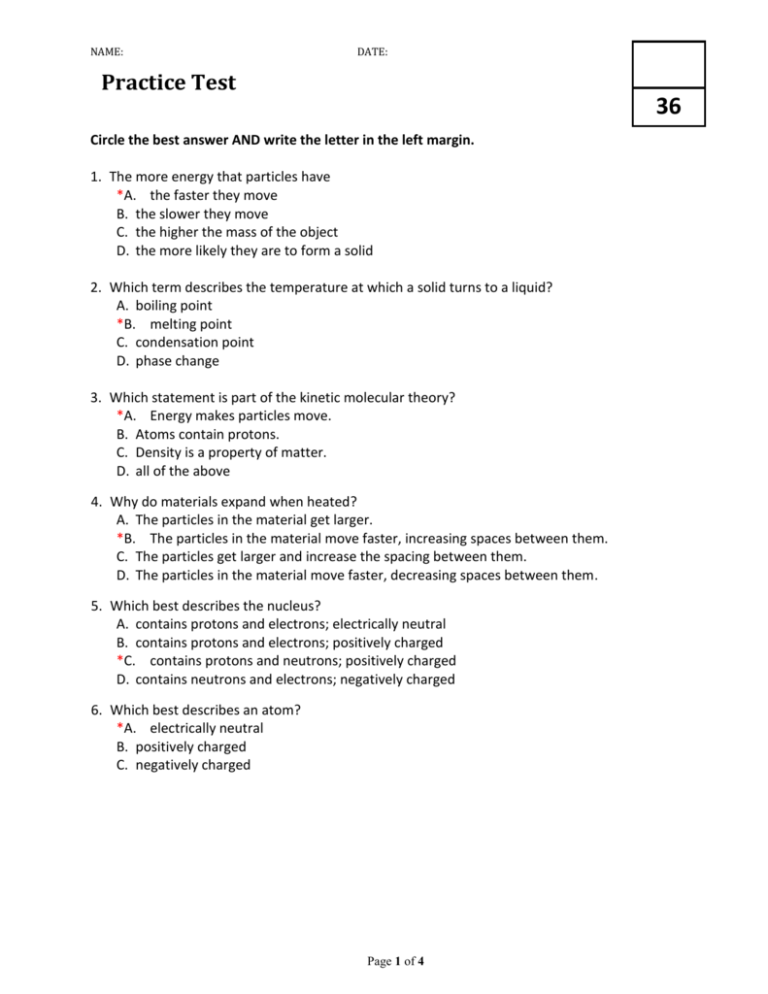Chapter1&2PracticeTestKEY
advertisement

NAME: DATE: Practice Test 36 Circle the best answer AND write the letter in the left margin. 1. The more energy that particles have *A. the faster they move B. the slower they move C. the higher the mass of the object D. the more likely they are to form a solid 2. Which term describes the temperature at which a solid turns to a liquid? A. boiling point *B. melting point C. condensation point D. phase change 3. Which statement is part of the kinetic molecular theory? *A. Energy makes particles move. B. Atoms contain protons. C. Density is a property of matter. D. all of the above 4. Why do materials expand when heated? A. The particles in the material get larger. *B. The particles in the material move faster, increasing spaces between them. C. The particles get larger and increase the spacing between them. D. The particles in the material move faster, decreasing spaces between them. 5. Which best describes the nucleus? A. contains protons and electrons; electrically neutral B. contains protons and electrons; positively charged *C. contains protons and neutrons; positively charged D. contains neutrons and electrons; negatively charged 6. Which best describes an atom? *A. electrically neutral B. positively charged C. negatively charged Page 1 of 4 Match the Term on the left with the best Descriptor on the right. Each Descriptor may be used only once. Term B_____ E_____ D_____ G_____ A_____ C_____ 7. nucleus 8. electron 9. conductive 10. malleable 11. neutron 12. ductile Descriptor A. B. C. D. E. F. G. H. I. a subatomic particle with a charge of zero dense part of an atom able to be drawn into a wire able to transmit heat or electricity occupies an energy level surrounding the nucleus change in state from liquid to gas able to be hammered into a sheet ratio of mass to volume a measure of hardness Short Answer Questions [1 mark for each part] 13. (a) Rutherford’s model of the atom resulted from an experiment in which alpha particles were made to pass through a thin gold sheet. Most alpha particles passed straight through, but some were deflected. Explain what Rutherford was able to conclude from this about the composition of atoms. That atoms contain a nucleus which is the densest part of the atom and electrons move around it. (b) Bohr studied the results of experiments on the light released by gaseous samples of atoms, such as those of hydrogen. What was he able to conclude from this about the way electrons exist in atoms? Electrons exist in specific energy levels or “shells”. 14. (a) Where is 99.99% of the mass in an atom located? The nucleus. (b) Which particles in an atom occupy 99.99% of the volume of the atom? Electrons take up the most volume since they can orbit far away from the nucleus. (c) Where is all of the positive charge in an atom located? In the protons of the nucleus. Page 2 of 4 Circle the best answer AND write the letter in the left margin. 15. Which of the following is a metalloid? A. sodium B. sulphur *C. silicon D. strontium 16. What is a period in the Periodic Table? A. a vertical column *B. a horizontal row C. a family of elements with similar properties D. a group of elements all of which have the same number of valence electrons 17. What do the noble gases He and Kr have in common? A. The same number of electrons B. The same number of valence electrons *C. Filled valence shells D. Both gases will make a balloon tend to float. 18. How is the periodic table arranged? A. by atomic mass and chemical properties B. by ion charge and atomic mass C. by ion charge and atomic number *D. by atomic number and chemical properties 19. Which phrase is correct for a Bohr model of any metal ion? *A. more protons than electrons B. more electrons than protons C. equal numbers of protons and electrons D. equal number of neutrons and protons 20. Which best describes the alkaline earth metal family? A. family of metals that is magnetic B. family of metals used to make coins C. the most reactive family of metals *D. family whose elements have two valence electrons 21. Which best describes an element? *A. a pure substance that cannot be broken down or separated into simpler substances B. a pure substance that can be decomposed further by physical means C. a mixture of different kinds of atoms, with the same number of protons D. a family of substances all of which have similar properties Page 3 of 4 Match the Term on the left with the best Descriptor on the right. Each Descriptor may be used only once. Term F_____ 22. atomic mass G_____ 23. noble gases B_____ 24. atomic number H_____ 25. Bohr model D_____ 26. metalloid A_____ 27. alkali metal Descriptor A. B. C. D. E. F. G. H. a family of chemically reactive elements the number of protons in an atom contain the element fluorine has properties of both metals and non-metals compares the inside of an atom to a raisin bun the mass of an average atom of an element family of chemically unreactive gases shows the arrangement of electrons in an atom Short Answer Questions 28. Calcium’s atomic number is 20. (a) Draw a simple Bohr diagram showing the # protons, # neutrons, the symbol and the number of electrons in each energy level for the atoms listed. [4 marks] Calcium Phosphorus (b) Draw a simple Bohr diagram showing the # protons, # neutrons, the ion symbol and number of electrons in each energy level of an oxide ion . [2 marks] Page 4 of 4








